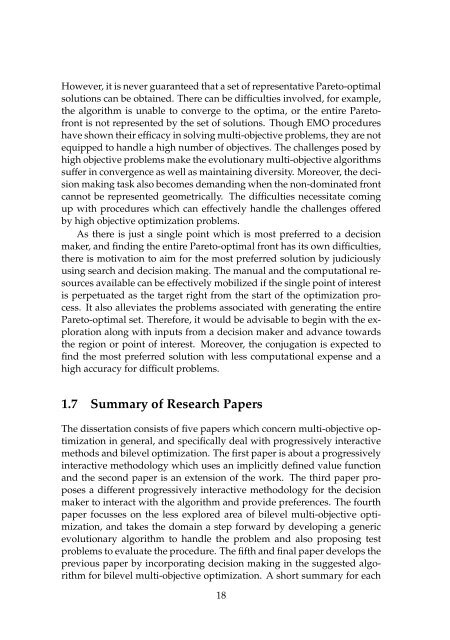Progressively Interactive Evolutionary Multi-Objective Optimization ...
Progressively Interactive Evolutionary Multi-Objective Optimization ...
Progressively Interactive Evolutionary Multi-Objective Optimization ...
You also want an ePaper? Increase the reach of your titles
YUMPU automatically turns print PDFs into web optimized ePapers that Google loves.
However, it is never guaranteed that a set of representative Pareto-optimal<br />
solutions can be obtained. There can be difficulties involved, for example,<br />
the algorithm is unable to converge to the optima, or the entire Paretofront<br />
is not represented by the set of solutions. Though EMO procedures<br />
have shown their efficacy in solving multi-objective problems, they are not<br />
equipped to handle a high number of objectives. The challenges posed by<br />
high objective problems make the evolutionary multi-objective algorithms<br />
suffer in convergence as well as maintaining diversity. Moreover, the decision<br />
making task also becomes demanding when the non-dominated front<br />
cannot be represented geometrically. The difficulties necessitate coming<br />
up with procedures which can effectively handle the challenges offered<br />
by high objective optimization problems.<br />
As there is just a single point which is most preferred to a decision<br />
maker, and finding the entire Pareto-optimal front has its own difficulties,<br />
there is motivation to aim for the most preferred solution by judiciously<br />
using search and decision making. The manual and the computational resources<br />
available can be effectively mobilized if the single point of interest<br />
is perpetuated as the target right from the start of the optimization process.<br />
It also alleviates the problems associated with generating the entire<br />
Pareto-optimal set. Therefore, it would be advisable to begin with the exploration<br />
along with inputs from a decision maker and advance towards<br />
the region or point of interest. Moreover, the conjugation is expected to<br />
find the most preferred solution with less computational expense and a<br />
high accuracy for difficult problems.<br />
1.7 Summary of Research Papers<br />
The dissertation consists of five papers which concern multi-objective optimization<br />
in general, and specifically deal with progressively interactive<br />
methods and bilevel optimization. The first paper is about a progressively<br />
interactive methodology which uses an implicitly defined value function<br />
and the second paper is an extension of the work. The third paper proposes<br />
a different progressively interactive methodology for the decision<br />
maker to interact with the algorithm and provide preferences. The fourth<br />
paper focusses on the less explored area of bilevel multi-objective optimization,<br />
and takes the domain a step forward by developing a generic<br />
evolutionary algorithm to handle the problem and also proposing test<br />
problems to evaluate the procedure. The fifth and final paper develops the<br />
previous paper by incorporating decision making in the suggested algorithm<br />
for bilevel multi-objective optimization. A short summary for each<br />
18
















